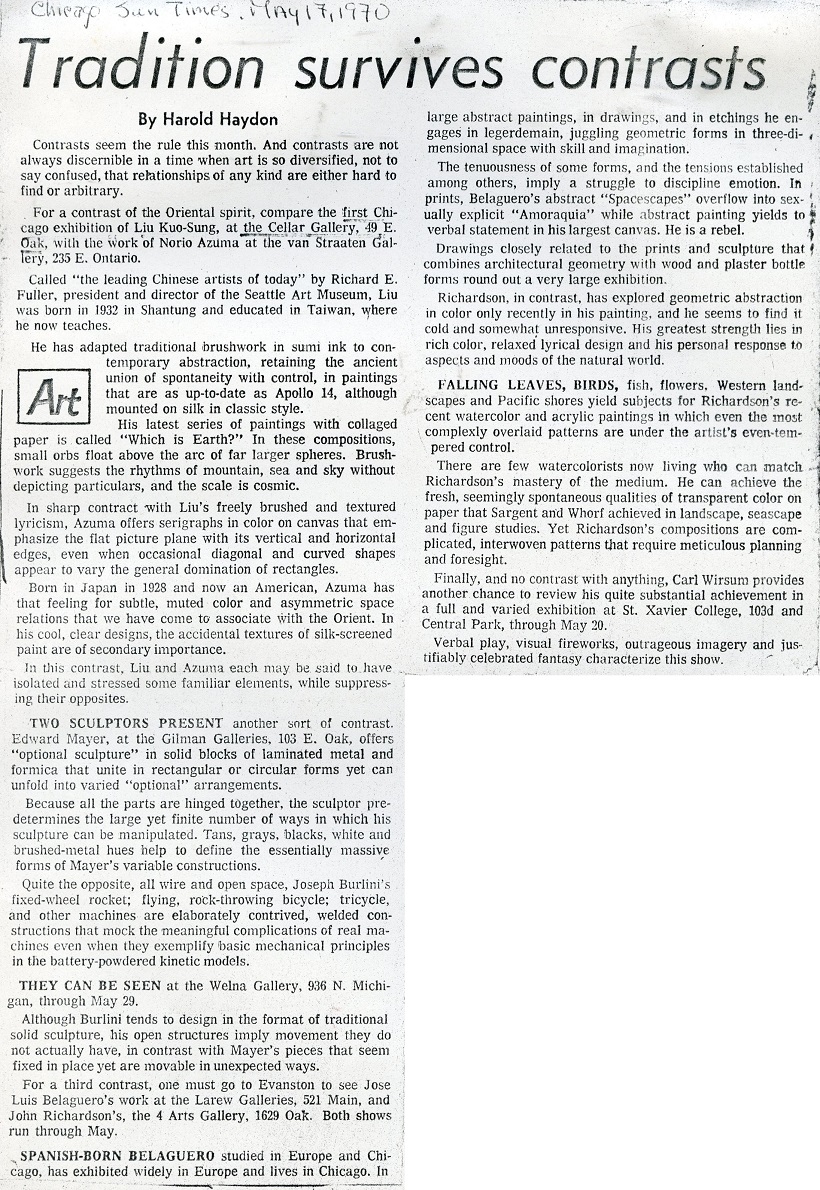Tradition survives contrasts
- 期刊與書籍
- Chicago Sun Times
- Harold Haydon
- 1970.5
Contrasts seem the rule this month. And contrasts are not always discernible in a time when art is so diversified, not to say confused, that relationships of any kind are either hard to find or arbitrary.
For a contrast of the Oriental spirit, compare the first Chicago exhibition of Liu Kuo-Sung, at the Cellar Gallery, 29 E. Oak, with the work of Norio Azuma at the van Straaten Gallery, 235 E. Ontario.
Called “the leading Chinese artists of today” by Richard E. Fuller, president and director of the Seattle Art Museum, Liu was born in 1932 in Shantung and educated in Taiwan, where he now teaches.
He has adapted traditional brushwork in sumi ink to contemporary abstraction, retaining the ancient union of spontaneity with control, in paintings that are as up-to-date as Apollo 14, although mounted on silk in classic style.
His latest series of paintings with collaged paper is called “Which is Earth?” In these compositions, small orbs float above the arc of far larger spheres. Brushwork suggests the rhythms of mountain, sea and sky without depicting particulars, and the scale is cosmic.
In sharp contrast with Liu’s freely brushed and textured lyricism, Azuma offers serigraphs in color on canvas that emphasize the flat picture plane with its vertical and horizontal edges, even when occasional diagonal and curved shapes appear to vary the general domination of rectangles.
Born in Japan in 1928 and now an American, Azuma has that feeling for subtle, muted color and asymmetric space relations that we have come to associate with the Orient. In his cool, clear designs, the accidental textures of silk-screened paint are of secondary importance.
In this contrast, Liu and Azuma each may be said to have isolated and stressed some familiar elements, while suppressing their opposites.
Two sculptors present another sort of contrast. Edward Mayer, at the Gilman Galleries, 103 E. Oak, offers “optional sculpture” in solid blocks of laminated metal and formica that unite in rectangular or circular forms yet can unfold into varied “optional” arrangements.
Because all the parts are hinged together, the sculptor predetermines the large yet finite number of ways in which his sculpture can be manipulated. Tans, grays, blacks, white and brushed-metal hues help to define the essentially massive forms of Mayer’s variable constructions.
Quite the opposite, all wire and open space, Joseph Burlini’s fixed-wheel rocket; flying, rock-throwing bicycle; tricycle, and other machines are elaborately contrived, welded constructions that mock the meaningful complications of real machines even when they exemplify basic mechanical principles in the battery-powered kinetic models.
They can be seen at the Welna Gallery, 936 N. Michigan, through May 29.
Although Burlini ends to design in the format of traditional solid sculpture, his open structures imply movement they do not actually have, in contrast with Mayer’s pieces that seem fixed in place yet are movable in unexpected ways.
For a third contrast, one must go to Evanston to see Jose Luis Belaguero’s work at the Larew Galleries, 521 Main, and John Richardson’s, the 4 Arts Gallery, 1629 Oak. Both shows run through May.
Spanish-born Belaguero studied in Europe and Chicago, has exhibited widely in Europe and lives in Chicago. In large abstract paintings, in drawings, and in etchings he engages in legerdemain, juggling geometric forms in three-dimensional space with skill and imagination.
The tenuousness of some forms, and the tensions established among others, imply a struggle to discipline emotion. In prints, Belaguero’s abstract “Spacescapes” overflow into sexually explicit “Amoraquia” while abstract painting yields to verbal statement in his largest canvas. He is a rebel.
Drawings closely related to the prints and sculpture that combines architectural geometry with wood and plaster bottle forms round out a very large exhibition.
Richardson, in contrast, has explored geometric abstraction in color only recently in his painting, and he seems to find it cold and somewhat unresponsive. His greatest strength lies in rich color, relaxed lyrical design and his personal response to aspects and moods of the natural world.
Falling leaves, birds, fish, flowers, Western landscapes and Pacific shores yield subjects for Richardson’s recent watercolor and acrylic paintings in which even the most complexly overlaid patterns are under the artist’s even-tempered control.
There are few watercolorists now living who can match Richardson’s mastery of the medium. He can achieve the fresh, seemingly spontaneous qualities of transparent color on paper that Sargent and Whorf achieved in landscape, seascape and figure studies. Yet Richardson’s compositions are complicated, interwoven patterns that require meticulous planning and foresight.
Finally, and no contrast with anything, Carl Wirsum provides another chance to review his quite substantial achievement in a full and varied exhibition at St. Xavier College, 103d and Central Park, through May 20.
Verbal play, visual fireworks, outrageous imagery and justifiably celebrated fantasy characterize this show.
